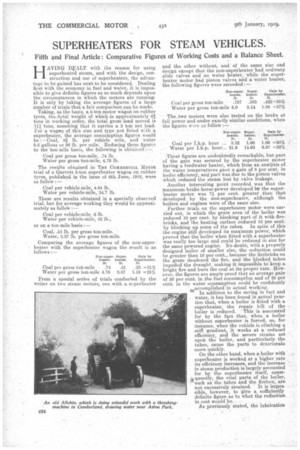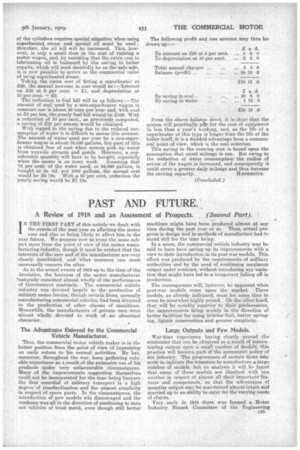SUPERHEATERS FOR STEAM VEHICLES.
Page 14

Page 15

If you've noticed an error in this article please click here to report it so we can fix it.
Fifth and Final Article: Comparative Figures of Working Costs and a Balance Sheet
HAVING Df,ALT with the reason for using superheated steam, and with the design, construction and use of superheaters, the advantage to be gained has next to be considered. Dealing first with the economy in fuel and water, it is impossible to give definite figures as so much depends upon the circumstances in which the motors are running. It is only by taking the average figures of a large number of trials that a fair comparison can be made. Taking, as the basis, a 5-ton motor wagon on rubber Lyres, the total weight of which is approximately df tons in working order' the total gross load moved is 111 tons, assuming that it carries a 5 ton net load. For a wagen of this size and type not fitted w:th a superheater, the average consumption figures would be :—Coal, st lb. per vehicle mile, and water 5.6 gallons or 56 lb. per mile. Reducing these figures to the ton-mile basis, the following is obtained : Coal per gross ton-mile, .74 lb. Water per gross tori-mile; 4.76 lb.
The results obtained in THE COMMERCIAL MOTOR trial of a Garrett 5-ton superheater wagon on rubber tyres, published in the issue of 6th June, 1912, were as follow :— .
Coal per vehicle-mile, 4.84 lb. Water per vehicle-mile, 34.7 lb.
These are results obtained in a specially observed trial, but for average working they would be approximately as folloiv :— Coal per vehicle-mile. 6 lb. Water per vehicle-mile, 42 lb., or on a ton-mile basis :— Coal, .51 lb. per gross ton-mile. Water, 157 lb. per gross ton-mile.
Comparing the average figures of the non-superheater with the superheater wagon the result is as follows :—
Non-superSuperOen by heater. heater. Superheater. lb. lb. lb.
Coal per gross ton-mile .74 .51 .23 =31% Water per gross ton-mile 9.76 3.57 1.19 =25% From a special series of trials conducted by the writer on two steam motors, one with a superheater and the other without, and of the same size and design except that the non-superheater had ordinary slide valves and no water heater, while the superheater motor had piston valves and a water heater, the following figures were recorded :— Non-superSuperGain by
heater. heater. Superheater.
lb. lb. lb.
Coal per gross ton-Mile .757 .335 .422=55% Water per gross ton-mile 5.0 3.14 1-86 =37% The ,two motors were also tested on the brake at • full power and under exactly similar conditions, when the 'figures were as follow :— heater. heater. Superheater. lb r. Non-superSuper.
Coal per I.h.p. hour ... 3.32 1.66 1.66 =50% • Water per I.h.p. hour... 21.9 14.93 6.97 =32% These figures are undoubtedly remarkable, but part of the gam was secured by the superheater motor having a feedwater heater, which from an analysis of the water temperatures gave a gain of 8 per cent. in . boiler efficiency, and part was due to the piston valves which reduced the steam lost by.valve leakage.
Another interesting point recorded was that the maximum brake horse-power developed by the superheater motor was 71, per cent. greater than that . developed by the -non-superheater, although the boilers and engines were of the same size.
Further trials on the superheater motor were carried out, in which the grate area of the boiler was reduced 10 per cent. by blocking part of it with firebricks, and the heating surface reduced 10 per cent. by blocking up some of the tubes. In spite of this the engine still developed its maximum power, which proved that the boiler when fitted with a superheater was really too large and could be reduced in size for the same powered engine. No doubt, with a properly designed boiler of smaller size, the reduction could be greater than 10 per cent., because the firebricks on the grate deadened the fire, and the blocked tubes impeded the draught, making it impossible to keep a, bright fire and burn the coal at its proper rate. However, the figures are ample proof that an average gain of 30 per cent, in the fuel consumptlon and of 25 per cent. in the water consumption could be confidently accomplished in actual working. • In addition to the saving in fuel and water, it has been found in actual practice that, when a boiler is fitted with a superheater, the repair bill of the boiler is reduced. This is accounted for by the fact that, when a boiler without superheater is forced, as, for instance, when the vehicle is climbing a stiff gradient, it works at a reduced efficiency, and the severe strains set upon the boiler, and particularly the tubes, cause the parts to deteriorate more quickly. On the other band, when a boiler with superheater is worked at a higher rate its efficiency increases, and the increase in steam production is largely accounted for by the superheater itself, consequently, the vital parts of the boiler, such as the tubes and the firebox, are not excessively strained. It is impossible, however, to give a. sufficiently definite figure SS to what the reduction in cost would be.
As previously stated, the lubrication of the cylinders requires special attention when using superheated steam and special oil must be used ; therefore, the oil bill will be increased. This, however, is only a small item in the cost of running a motor wagon, and, by assuming that the extra cost in lubricating oil is balanced by the saving in boiler repairs, which will most decidedly be on the safe side, it is now possible to arrive at the commercial value of using superheated steam.
Taking the extra cost of fitting a superheater at 220, the annual increase in cost would be :—Interest on 220 at 5 per cent. = 21, and depreciation at 10 per cent= 22.
The reduction in fuel bill will be as follows : —The amount of coal used by a non-superheater wagon In constant use is 'about 50 tons per year and, -with coal at 22 per ton, the yearly fuel bill would be 2100. With a reduction of 30 per cent., as previously computed, a saving of 230 per annum would be obtained. With regard to the saving due to the reduced consumption of water it is difficult to assess this amount. The amount of water used per year by a non-superheater wagon is about 70,000 gallons, but part of this is obtained free of cost when motors pick up water from wayside streams and ponds. However, a considerable quantity will have to be bought, especially when the motor is on town work. Assuming that 75 per cent, of the water used, or 52.500 gallons, is bought at 2s. 6d. per 1000 gallons, the annual cost would he 26 12s. With a 25 per cent, reduction the yearly saving would be 21 13s. From the above balance sheet, it is clear that the system will practically pl'y for the cost of equipment in less than a year's working, and, as the life of a superheater of this type is longer than the life of the boiler itself, it is a decided advantage from a commercial point of view, which is the real criterion.
This saving in the running cost is based upon the assumption that equal mileage is run. But owing to the reduction of water consumption• the radius of action of the wagon is increased, and consequently it could cover a greater daily mileage and thus increase the earning capacity.






















